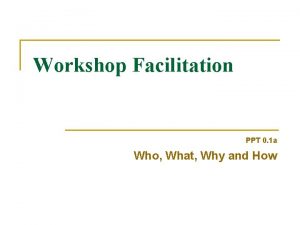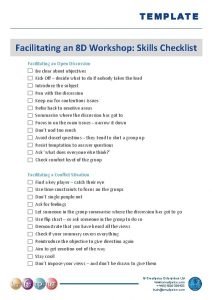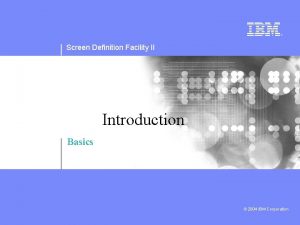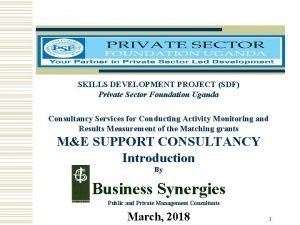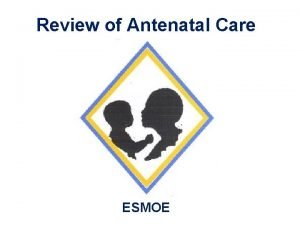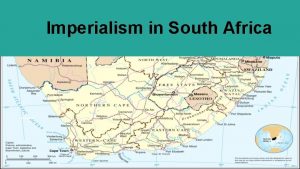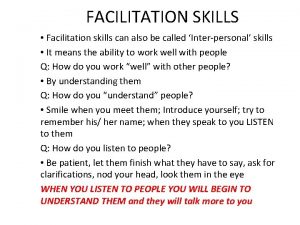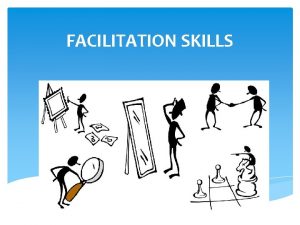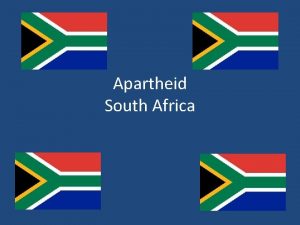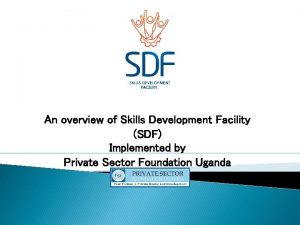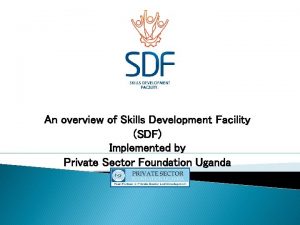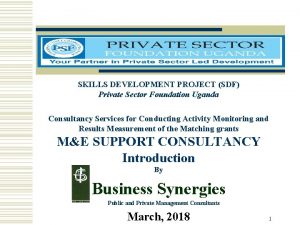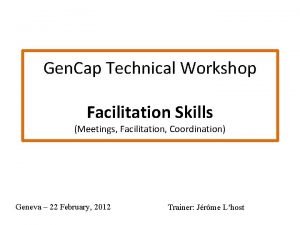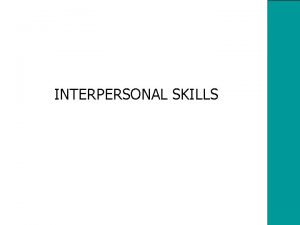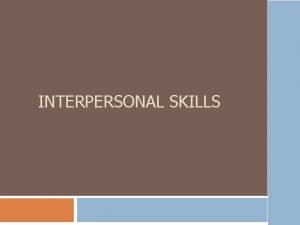SKILLS DEVELOPMENT FACILITATION IN SOUTH AFRICA AN SDF


























- Slides: 26

SKILLS DEVELOPMENT FACILITATION IN SOUTH AFRICA

AN SDF NEEDS TO: Facilitate the development of employees in the organization and the strategies of the organization equally and fairly. Acquire the resources to accredit and evaluate learnerships and skills programs in the organization. Evaluate the skills development needs of the employees and organization and continually evaluate the implementation of identified needs. Advise the employees and the employer on external and internal skills strategies as well as the progress of the skills development of the organization. Be a training committee leader and lead the process of organizational skills development and employee development. Act as SDF administration and check all SETA documentation before submitting. Set up a training committee. Advise the organization on the implementation of the WSP. Advise the organization on the quality assurance requirements of the relevant SETA. Serve as contact person between the organization and the external SDF and SETA. Chair the skills development planning committee or training committee.

AN SDF NEEDS TO: Bring the company policies in line with the regulations as laid down by the Skills Development Act. Assist in the creation of a performance management system for the organization where no performance management system exists. Generate the key performance areas relevant to training and development for the performance management system. Complete an individual development pathway for all employees, as well as the skills requirement and learning pathway. Create a portfolio of evidence for all employees that will receive training in the company. Complete the workplace skills plan, interim training reports and annual training reports and submit it to the correct SETA, before the deadline. Formalize the qualifications of employees through recognition of prior learning. Train employed staff in order to claim the skills development levies from the SETA Register Learnership Programs by training and unemployed people. Claim their skills development levies from their SETA and claim the Tax rebates as stipulated for Learnerships.

ETD IN SOUTH AFRICA �Previous ETD in SA = Measured mostly knowledge (theory) �Current ETD in SA = Measures knowledge (theory), skill (practical) & attitude

National Skills Development Strategy � Formulated in 5 year plans � 1 st plan ran from 2001 to 2005 � 2 nd plan ran from 2005 – 2010 � 3 rd plan runs from 2010 – 2016 NSDS 3 follows the integration of higher and further education and skills development into a single Department of Higher Education and Training. Promotes partnerships between employers, public education institutions (FET’s, universities etc) and training providers and SETA’s.

National Skills Development Strategy places emphasis on Relevance Quality Sustainability of skills programmes to ensure that they impact positively on poverty reduction and the eradication of inequalities.

NSDS (III) GOALS 1. 2. 3. 4. 5. 6. 7. 8. Establishing a credible institutional mechanism for skills planning; Increasing access to occupationally directed programmes intermediate level; Promoting the growth of a public FET college system that is responsive to sector, local, regional and national skills needs & priorities; Addressing the low level of youth and adult language and numeracy skills to enable additional training; Encouraging better use of workplace-based skills development; Encouraging & supporting cooperatives, small enterprises, workerinitiated, NGO & community training initiatives; Increasing public sector capacity for improved service delivery & supporting the building of a developmental state; Building career and vocational guidance.

NSDS (III) PIVOTAL PROGRAMMES Important pillar: Professional, vocational, occupational, technical and academic learning (PIVOTAL) learning programmes; Provides a full occupationally-directed qualification; Usually institutionalized training upon arrangement with SETA and employer.

NSDS (III) SETA ACCOUNTABILITY Preparation, development and implementation of a SSP which addresses the training & development needs of the sector. SSP updated annually to reflect current skills development needs and trends within the sector; 2. Facilitating the development and maintenance of relevant qualifications, unit standards & skills programmes for the sector; 3. Promoting the development of skills for all people employed in the sector; 4. Encouraging continuous upgrade of skills in the workforce, provide opportunities for work experience and employ new staff when opportunities occur; 1.

NSDS (III) SETA ACCOUNTABILITY 5. 6. 7. 8. Promoting and registering Learnerships and other skills development programmes; Quality Assuring education and training in the sector, through the establishment and maintenance of quality assurance systems, the accreditation of training providers, assessors & the approval of training materials; Improving the employment prospects of disadvantaged individuals by assisting work seekers to become skilled and work ready. Increasing the levels of investment in education & training in the sector; The management of levy income & disbursements of grants to ensure the development of skills and economic growth within the sector.

LEGISLATION The following pieces of legislation impact education and training in South Africa: The South African Qualifications Authority Act - replaced with the National Qualifications Act of 2008 to make training effective; The Skills Development Amendment Act – to make training occupationally relevant; The Skills Development Levies Act – to make training affordable; The National Qualifications Framework Act – addresses the purpose, functions and responsibilities of the new Quality Council for Trades and Occupations (QCTO); The Employment Equity Act – to make training equitable; The Broad Based Black Economic Empowerment Act.

EMPLOYMENT EQUITY The right to equality forms part of our Constitution. These rights and aims are : To promote equal opportunity and fair treatment in employment through the elimination and prohibition of unfair discrimination; To ensure equal representation in all occupational categories by the implementation of affirmative action measures for “designated groups”. The Act classifies a “designated group” as black people (this definition includes Blacks, Coloureds and Indians/Asians), women and people with disabilities.

OBE - FOUNDATIONAL CONCEPTS 1. 2. 3. 4. 5. 6. 7. NQF – National Qualifications Framework: structure that organises and classifies qualifications and competencies in SA. Consist of registered unit standards and qualifications at 10 levels. SAQA – South African Qualifications Authority: main body responsible for implementation of NQF. SETA – Sector Education and Training Authority: a statutory body that administrates education and training within a particular sector of industry. OBET – Outcome-based Education and Training: focuses on learning outcomes to be achieved. Learning programmes are designed to help learners achieve those outcomes. ETQA – Education and Training Quality Assurance Body: a body that is responsible for quality assurance of education and training. NSA – National Skills Authority: a statutory body that oversees the work of the SETA’s ETD – Education and Training Development

National Qualifications Framework A structure that organises and classifies qualifications and competencies in SA. Consist of registered unit standards and qualifications at 10 levels. NQF BANDS NQF LEVELS NQF 7 – 10 SKILL LEVEL OFO MAJOR GROUPS 4 NSDS (2) Professionals High (1) Managers Higher Education Band (HET) NQF 6 3 (3) Technicians & Associate Professionals Intermediate NQF 5 NQF 4 Further Education Band (FET) 2 (4) Clerical Support Workers (5) Service and Sales Workers (6) Skilled Agricultural, Forestry, Fishery, Craft & related Trades Workers NQF 3 NQF 2 General Education Band (GED) (7) Plant and Machine Operators and Assemblers NQF 1 Entry 1 (8) – Elementary Occupations

NQF STRUCTURE Minister of Labour NSA SAQA Higher education HEQC Subject Specialist Panels SETA Further education SGB Umalusi ETQA General Education Chamber SGB Standards ETQA

NQF PRINCIPLES Principle Description Integration To allow a unified approach to education and training across different areas and levels of learning, and between different components of the learning delivery system. Relevance To be responsive to national development needs Credibility To have international and national value and acceptance Coherence To work with a consistent framework of principles and certification Flexibility To allow for multiple pathways to the same learning ends Standards To be expressed in term of a nationally agreed framework and internationally acceptable outcomes Legitimacy To provide for the participation of all national stakeholders in the planning and co-ordination of learning end-points Access To provide ease of entry to appropriate levels of education and training for all prospective learners in a manner which facilitates progression Articulation To provide for learners, on successful completion of accredited prerequisites, to move between components of the delivery system. Progression To ensure that the framework of qualifications permits individuals to move through the levels of national qualifications via different combinations of learning programmes. Portability To enable learners to transfer credits of qualifications from one learning institution and/or employer to another RPL To give credit to learning which has already been acquired in different ways though assessment. Guidance of learners To provide counselling to learners by specially trained individuals who meet nationally recognized standards for educators and trainers.

SOUTH AFRICAN QUALIFICATIONS AUTHORITY The main body responsible for implementation of NQF. Standards creation functions of SAQA Quality assurance functions of SAQA Creating structures for generating standards. Ensure that quality of standards is maintained. Register standards generating bodies. Accredit education and training quality assurance bodies. Register national standards. Ensure that national standards are comparable with international standards.

SOUTH AFRICAN QUALIFICATIONS AUTHORITY SAQA is the official guardian of the NQF, having the responsibility of making the NQF work, which they do through the two directorates of SAQA: 1. The Standards Setting directorate watches over the development of the NQF: A Creating unit standards & qualifications through bodies known as the standards advisory panels and Standards Generating Bodies (SGB’s) B Defining how these bodies are created and run, and; 2. The Quality Assurance directorate watches over the implementation of the NQF: A Ensuring the delivery of high quality training and education in those unit standards and qualifications, which they do through what are known as Education and Training Quality Assurance bodies (ETQA’s)

UNIT STANDARDS A unit standard (u/s): Is the description of the expected end points (or outcomes) of learning for which a learner will get credit. Is the smallest unit that can be credited to a learner. can stand alone, or can be grouped into clusters to form skills programmes or be combined to form learning programmes.

WHAT DOES UNIT STANDARDS CONTAIN? 1. 2. 3. 4. 5. 6. 7. Title: Defines a coherent knowledge, understanding or skills; Unit Standard Number: unique to each unit standard; Level: shows at which level of the NQF the standard is registered; Credits: indicates the time an average learner would take to achieve this standard (1 credit = 10 notional working hours); Purpose statements: this gives additional information to further expand on the title; Learning assumed to be in place: indicates the level of skill and knowledge required of a learner; Specific outcomes: these are the specific outcomes that make up this unit standard

WHAT DOES UNIT STANDARDS CONTAIN? 8. 9. 10. 11. 12. 13. Assessment criteria: states the evidence required to establish whether the learner has achieved that specific outcome and often implies the most appropriate method for collecting that evidence. Range statement: a range statement may be included under the specific outcome or the assessment criteria to give the context. The range statement is intended to minimise variations of interpretation. Accreditation option: this section gives information on how the qualification must be registered and accredited by the Awarding Body Moderation option: the moderation requirements must be satisfied before credit is awarded for the standard. This explains the kind of moderation with which users of the unit standard must comply. Critical Cross Field Outcomes (see the section on CCFO’s) Essential Embedded Knowledge (see the section on EEK’s)

WHAT IS AN OUTCOME? 1. 2. Outcomes are the demonstrable and measurable end products of a learning process. Can include reference to the learners achievements in the following areas: 3. Actions that are performed Roles that are acted out Knowledge that is evidenced Understanding that is shown Skills that are demonstrated Values and attributes that a learner has to demonstrate Outcomes also refer to the criteria against which the learners achievements will be assessed and the particular contexts of these achievements.

DIFFERENT KINDS OF OUTCOMES There are two types of outcomes: 1. Critical cross-field outcomes (CCFO’s) CCFO’s are the foundation stones upon which other skills are built. Regardless of the qualification, the development of these critical outcomes is vital to: Effective performance in the workplace Developing the capacity of life-long learning 2. Specific Outcomes (SO) Specific Outcomes that are specific to certain occupations and fields of learning; (a specific outcome is the ability to use knowledge, skills and values specific to a particular learning field or occupation).

CCFO’S There are 8 CCFO’s that have been identified to date: 1. 2. 3. 4. 5. 6. 7. 8. Identifying and solving problems Working effectively with others Organising and managing oneself Collecting, analysing, organising and critically evaluating information Communicating effectively (numbers and words) Using science and technology and showing responsibility to the environment Understanding the world as a set of related systems Contributing to the full personal development of an individual through awareness of: How to learn more effectively How to be a more responsible person How to be culturally and aesthetically aware How to explore education and career opportunities How to develop entrepreneurial opportunities

EEK’S Essential embedded knowledge describes the knowledge base required for competent performance and achievement of the unit standard. This underpinning knowledge will ensure that the learner understands the contextual knowledge and can apply it to the skills required. Examples are: The essential concepts, principles, structures and terminology of an outcomes- based system. Methods of facilitating group processes and the dynamics involved. Methods of gathering, analysing and recording data Key mechanisms for training and developing people.

DIFFERENT UNIT STANDARDS There are three different kinds of unit standards: FUNDAMENTAL Are the basic knowledge people need to know in order to do their work better. CORE Are the knowledge you need in order to perform the job and seen as competent. All qualifications from Different functional areas levels 1 -4 MUST have at or jobs will have a least 36 credits here of different set of core units. which 16 credits must be from maths and 20 credits from communication and languages. ELECTIVE Include all the units that you want to give the learners some choice over. More specialised areas in the qualification.
 Historical perspective of community development
Historical perspective of community development Conclusion for training and development ppt
Conclusion for training and development ppt Open-ended meaning
Open-ended meaning Workshop checklist template
Workshop checklist template Developing facilitation skills
Developing facilitation skills Advantage arrest silver diamine fluoride instructions
Advantage arrest silver diamine fluoride instructions Sdf ii
Sdf ii Sdf uganda
Sdf uganda Dentist calgary sdf
Dentist calgary sdf Tretention
Tretention Agrement south africa
Agrement south africa Herbalife levels and income
Herbalife levels and income South africa unemployment rate by race
South africa unemployment rate by race Hamilton naki
Hamilton naki Unjust enrichment latin
Unjust enrichment latin South west asia and north africa map
South west asia and north africa map 11 official languages of south africa
11 official languages of south africa Musket
Musket How many capital cities in south africa
How many capital cities in south africa Anc card
Anc card Oxford university press south africa
Oxford university press south africa Six key priorities
Six key priorities Sa national archives
Sa national archives Ibm client center
Ibm client center Imperialism in south africa timeline
Imperialism in south africa timeline Zero hunger programme south africa
Zero hunger programme south africa Cultural geography of africa
Cultural geography of africa


